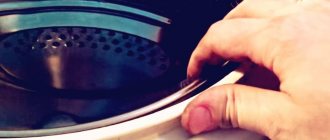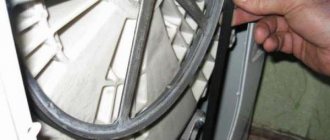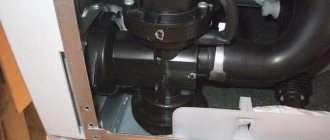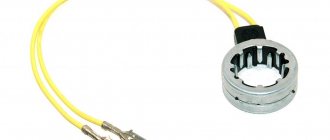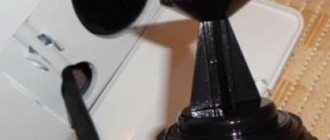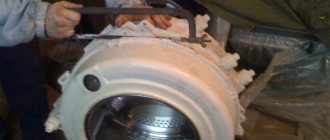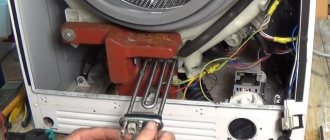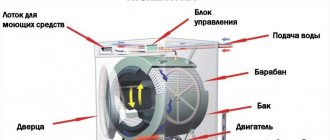When a housewife complains that her machine “doesn’t turn,” this phrase can characterize two types of problems with the drum. In the first case, the drum does not rotate at all, during any washing cycle. In the second case, the problem is expressed in the fact that the drum works during washing and rinsing, but cannot cope with the spin cycle and cannot reach the required speed.
A fairly common breakdown of washing machines is the drum not rotating, even though the machine is turned on, water is drawn in and drained.
If the owner notices that the drum of his washing machine does not rotate well, he often associates this problem with damage to the drum drive belt. This is not entirely true; more precisely, a belt break occupies only a small proportion of all the reasons for stopping. Most often the problem lies in problems with the engine. Perhaps the damage will not be too global, and minor repairs, for example, replacing brushes, will be sufficient. But there are often cases when such a breakdown affects the normal operation of the machine in washing or spinning mode and you need to seek the help of a specialist.
How to determine whether the problem is really in the belt or not? Very simple. When you take out laundry after washing, you usually spin the drum to check if there are any small items left in it. You need to remember these sensations and compare the resistance force during rotation in normal cases and now, after a problem has occurred. If this simple method fails to determine the problem, you will need to remove the rear panel of the unit and inspect the belt directly.
If the drum belt breaks
If the washing machine drum rotates slowly due to a broken belt, you need to find out the reason. Sometimes the belt can simply come off, for example, if too much laundry has been loaded. In other cases, this leads to more serious failures in the process:
- low quality drive belt;
- water entering directly onto the belt and resulting slippage;
- the drum pulley was removed;
- the bolt that attaches the engine to the drum is damaged or loosened;
- wear of the drum bearings, leading to the pulley rocking. In this case, you need to replace the bearing in the washing machine, as we discussed earlier;
- a small item of clothing getting stuck in the drum, which causes the belt to become too tight and may break. It's OK! Replacing a washing machine belt is easier than it sounds. See instructions at the link.
When checking the condition of the drive belt, the question arises: what is the permissible degree of its tension? It should be pulled with such force that when touched we can hear a ringing sound. However, overtightening will be unnecessary; there should be enough space on the sides so that it is possible to move the belt from one groove to another.
Prevention of the problem
To prevent breakdowns of the washing machine, it is necessary to carry out certain actions in a timely manner to protect it from factors of premature wear of parts and their breakdown. Prevention is as follows:
- Compliance with the operating standards of the machine indicated in the technical specifications (maximum and minimum weight of loaded laundry, chemical washing agents approved for use in this model). Control to prevent foreign objects from getting inside.
- Equipping the network with a stabilizing device that eliminates voltage drops.
- Clean the filter regularly (depending on the intensity of use).
- Equipping the water supply system with a special filter, including one that softens the water if it is too hard. This prevents debris from clogging the valves and scale on the heating element.
- The use of chemical agents that protect against scale, but strictly in accordance with the instructions, since they destroy rubber parts.
- Replacing the belt. Usually produced after 5 years of operation.
The main condition for the absence of breakdowns of the washing machine during the entire period of its use is compliance with all the conditions described in the operating instructions.
Before starting the device for the first time, you need to carefully study it, and then carry out proper care and, if you suspect a malfunction, promptly eliminate the cause.
If you cannot do this yourself, or if you have any doubts, you must use the services of a specialist.
The washing machine drum rotates poorly as a result of imbalance
Sometimes the drum rotates normally during washing, but the problem with stopping occurs directly during the spin cycle. In this case, we will talk about imbalance of the drum. Modern washing machines are equipped with a special system to detect the occurrence of imbalance. In this case, the machine simply reaches the spin cycle and turns off, because... the drum cannot reach the required speed. This situation can be caused by incorrectly distributed items on the drum, clumped items, for example in a duvet cover or other large item, or insufficient loading by weight.
To solve the problem, you need to turn off the machine and try to straighten the clumped items evenly throughout the drum, or add laundry of different sizes. Then you can run this wash cycle again, or try running only the spin cycle. If the issue is resolved, then the imbalance was indeed the cause.
Thus, stopping the drum due to a load that is not properly balanced can be easily resolved without outside help. Before calling a specialist, be sure to check if this is your case. But another, not so favorable option is also possible. If the drum rotates easily without load, but this is accompanied by a sharp, unpleasant creaking or crackling sound, then wear on the motor brushes may be to blame.
What causes weak rotation?
Before you take active action, you need to find the root cause of the drum braking. Depending on the nature and scale of the trouble that occurred, the tactics and methods of the required repairs will be determined . What problems might there be?
- Drum overload. Everything is logical here - if you exceed the maximum permissible load, the machine will refuse to rotate the shaft and risk the entire structure. Therefore, it is better to stop the cycle, open the door and take out some of the things.
- Broken engine. Braking of the drum or, on the contrary, sudden acceleration to an unprecedented speed often indicates a faulty motor.
- Electronic board failure. Failure of the electronic unit of the machine will inevitably lead to loss of control over the engine, which in turn will affect poor rotation of the drum.
It is strictly not recommended to repair, flash or replace the control board yourself - there is a high risk of permanently damaging the part.
The drum also does not rotate well if there is an internal short circuit or damage. This item includes several possible culprits, so diagnostics and correction should be carried out by specialists. To better understand what happened, it is worth conducting an initial diagnosis.
Carbon brush wear
Hotpoint
washing machines from Ariston often encounter problems in the form of drum stops . And there are often cases when this happens due to worn carbon brushes.
Don't rush too much and immediately go to the store for new brushes. First, you should carefully examine their appearance and the condition of the adjacent engine parts. If the reason for the engine stopping really lies in the brushes, then at least one of the two will be black and charred. If the places where the brushes are attached to the engine look like new, and the brushes themselves are not smoked, then most likely they do not need to be replaced. Even if they both look worn out, the breakdown may be much more global. If the fittings themselves are worn out, replacing the brushes with new ones can lead to other breakdowns. Therefore, it is still better to entrust the diagnosis of such damage to a professional.
Tips for preventing possible breakdowns
When working with a washing machine, you should follow a number of important rules to protect the drum mechanism from possible malfunctions.
- Empty pockets of clothing before washing.
- Observe the maximum allowed amount of laundry.
- Do not forcefully rotate the drum mechanism if it is out of order.
- Use descaling products with extreme caution.
By following these simple recommendations and general rules for caring for your automatic washing machine, you can reduce the risk of breakdowns in your washing machine and ensure its long life.
Other Possible Reasons for Drum Stopping
If the belt is not damaged and imbalance is excluded, then the possible nature of the cause of the breakdown is deeper, and it will be difficult to detect it on your own, without a specialist’s diagnosis. This could be a breakdown of the motor, a malfunction of the module or connections, the tachometer of the engine coil, a malfunction of the pressure switch, or a blockage of pressure in the system.
There may also be a problem with the pump, because if the water does not drain properly, the drum may not rotate well at high speeds. This is confirmed when there is water left in the machine after draining. In order to make sure that the problem is with the pump, you need to do a little research. It is necessary to run the spin cycle without loading laundry into the machine, because unspinned items will leave water in any case. If after draining you find that there is water in the drum, then the problem is really in the pump. It is worth considering that even during normal operation of the washing machine, 2-3 cups of water will remain inside it after draining; you can notice it by unscrewing the filter at the bottom or removing the pump.
Please rate the article:
Join on Telegram
We get foreign objects
So, the belt is in perfect order, let's move on to checking the drum. It is likely that a small object in the form of a clothing button or key got into the free space between the tank and the drum, and the element stopped rotating. In this case, operating the machine is not recommended, as the object may cause jamming or damage to the drum walls. In each case, the situation requires expensive repairs associated with replacing the internal parts of the machine.
It is easy to determine the presence of a foreign object in the tank. To do this, you need to open the loading hatch door and turn the drum manually, first in one direction, then in the other. The presence of resistance, extraneous grinding or ringing will indicate that you are on the right track. All that remains is to remove the foreign object as quickly as possible, and for this there will be difficult steps, since you will have to work with the drain filter or the hole located under the heating element.
The first algorithm of actions is as follows:
- At the bottom right we find a hatch intended for draining;
- open its lid;
- spread rags on the floor;
- remove the garbage filter;
- We clean the body, sleeve, pipes.
Larger items remain at the bottom of the machine tank. To get to them as quickly as possible, you will have to dismantle the back panel, turn off and remove the water heating element. All that remains is to use a flashlight to find a foreign object and remove it using wire or pliers
You will have to act carefully so as not to damage the tank body.
If the drum stops rotating and is completely jammed, the tank must be completely disassembled. We proceed as when replacing a bearing - remove the panels at the top and rear, dismantle the drive, electric motor, dispenser with module, counterweight elements, shock-absorbing devices and other machine components. After completing these works, we take out the main container, disassemble it and remove foreign objects. The difficulty arises if the tank of the car is made in a non-separable form. It will take four hours to complete the cut, and it is better to entrust such work to an experienced specialist.

